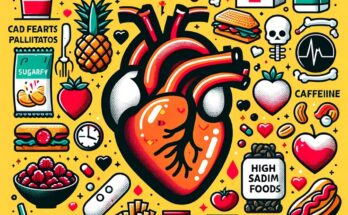Did you know that in Australia, 57 000 people suffer a heart attack every year? That’s one heart attack every 10 minutes. You’ve probably heard that your genetics has a part to play in your heart attack risk. But it’s not all out of your control.
Fortunately, there is a lot you can do to reduce your heart attack risk by following a healthy lifestyle.
Today, I’m going share with you my top 4 diet tips to help prevent heart attacks and boost heart health.
Tip number 1:
Omega 3 fatty acids Omega 3s are a type of fat that do have benefits when it comes to improving heart health.
There is some debate in the medical community about exactly how much benefit there is from taking Omega 3.
Early studies found that the risk of death from heart disease could be reduced by up to 36% by taking Omega 3s. But more recent studies like one released in March of 2018 suggested that the benefit could be much smaller, something like 7%.
But here’s the thing – every percentage point counts when it comes to preventing heart disease. So how much do you need?
And what about the different types of Omega 3s? Well, there are 3 main types of Omega 3 – EPA, DHA and ALA.
Studies have found that the benefit from Omega 3 tends to plateau after a certain point and this point is a total of 250mg of combined EPA and DHA.
That’s equivalent to having 2 serves of fish per week. If you’d rather take fish oil supplements, then 1 gram of fish oil per day is sufficient. If you don’t like fish or are vegetarian, then you’d be happy to know that there are Omega 3s in plants and that’s the ALA that I referred to earlier.
One thing to keep in the back of your mind is that the Omega 3 from plants, like ALA, are similar to the Omega 3s in fish but not exactly the same. It is assumed that plant-based Omega 3s also have some benefits for heart health, but we can’t say for sure.
The Australian Heart Foundation recommends 1 gram of plant-based ALA per day and that’s pretty easy to achieve.
30 grams of Walnuts contains 1.9 grams of ALA, 15 grams of Chia Seeds contains 2.7 grams and 1 tablespoon of Canola Oil contains 1.8 grams.
Tip Number 2:
Reduce Trans Fats Not all fats are created equal.
Even though Omega 3s can be protective, trans fats can increase the risk of heart attacks.
Saturated fats were thought to be the enemy, but now we’ve found that trans fats are even worse.

A study found that increasing our trans fat intake by just 2%, leads to a 93% increase in the risk of heart attacks.
That’s almost double!
The aim of a heart-friendly diet shouldn’t be to remove all fats from your diet. Fats are an important source of nutrition.
A more balanced strategy is to increase fats like Omega 3s and unsaturated fats from nuts, legumes and plant oils, while decreasing saturated fats and especially trans fats But where do trans fats come from?
And why do foods contain them? Trans fats are found in small amounts in nature, like in dairy or meat.
But it is the industrial production of food that has led to an increase in the amount of trans fats in our diet.
Trans fats are found in some margarines, butter, deep-fried foods and commercially manufactured baked goods like biscuits, cakes and pastries. That’s a lot of yummy food.
One important point is that even though regular consumption of trans fats can be harmful, the occasional pastry isn’t going to kill you.
It’s all about keeping it in perspective.
So try to reduce your trans fats where you can, but don’t be too upset with yourself if you have a slice of cake, especially if it’s your birthday.
Tip number 3:
Increase Fiber, Fiber is a part of our foods that can’t be digested. In a large study, women with high fibre intake had 47% less risk of heart attacks compared to women with low fibre intake.
One simple trick to increase your fibre intake is to choose whole grains rather than refined ones.
For example choosing brown rice or whole wheat bread, as compared to white rice or white bread.
Tip number 4:
Increase fruits and vegetables You knew this was coming! A large study of more than 120 000 people found that those with the highest intake of fruits and vegetables had a 20% lower risk of heart attacks compared to those with the lowest intake of fruits and vegetables.
The interesting thing is that, even though our supermarkets are full of fruits and vegetables, we still find it difficult to include them in our diet. And that’s because the way we eat is changing globally.
In Australia, the amount that we spend on eating out is increasing every year.
What we eat is being determined less by what we choose to include in our diet and more by what companies and restaurants feed us.
So it’s more important now than ever before to be more aware of the quality of the foods that we’re eating because ultimately it’s our health that gets affected by the food that we eat.
Thanks for watching and I’ll see you in the next one…

